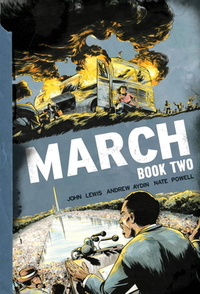Take a photo of a barcode or cover
emotional
informative
inspiring
tense
fast-paced
[I am going to copy/paste the same review for all 3 books in the trilogy]
MUST READ!
I initially heard of this trilogy of graphic novels because [b:March: Book Three|29436571|March Book Three (March, #3)|John Lewis|https://images.gr-assets.com/books/1457361267s/29436571.jpg|49704739] won a National Book Award this year, so I just borrowed all of them from the library. Reading these books made realize how LITTLE I knew about the Civil Rights Movement, triggered me to look into the photography of Danny Lyons, and investigate more writing from that era. Also, these graphic novels are works of art. READ THEM!
MUST READ!
I initially heard of this trilogy of graphic novels because [b:March: Book Three|29436571|March Book Three (March, #3)|John Lewis|https://images.gr-assets.com/books/1457361267s/29436571.jpg|49704739] won a National Book Award this year, so I just borrowed all of them from the library. Reading these books made realize how LITTLE I knew about the Civil Rights Movement, triggered me to look into the photography of Danny Lyons, and investigate more writing from that era. Also, these graphic novels are works of art. READ THEM!
emotional
informative
inspiring
fast-paced
emotional
informative
inspiring
medium-paced
dark
informative
inspiring
reflective
fast-paced
I really love this series because it is so informative. I love the artwork and learning about so many historical figures that I either vaguely heard of or never heard of them. I love to hear John's stories. It's sad that so many of this is happening again.
challenging
dark
emotional
hopeful
informative
reflective
sad
tense
medium-paced
I considered myself well-versed in the struggles for civil rights, but this book opened my eyes to atrocities happening behind the scenes.
March: Book Two minimizes the "frame story" aspect of the first book (although it is framed by Barak Obama's inauguration) and is heavily focused on two key parts of John Lewis' political activism career: the "Freedom Rides" down to the deep South (which were meant to test the Supreme Court decision outlawing segregation on buses) and the famous march on Washington with MLK, Jr.
Where March Book 2 particularly excels is driving home the stakes and price that everyone involved paid. As the movement makes progress, the white supremacist backlash becomes more brutal.
There is a lot of graphic violence. John Lewis and his fellow protestors get viciously beaten, abandoned in the woods at night, imprisoned. Children get sprayed with high-pressure firehoses. Dogs are released on protestors. Buses and churches get firebombed. It's disturbing stuff, because it really happened, and seeing it depicted, even just in comic form, is so much more powerful than simply reading about it in the abstract.
Book 2 also starts to explore, though not in as much detail as I might have liked, some of the fissures and disagreements within the Civil Rights movement as the non-violence tenet gets tested. Some members (Stokely Carmichael, for example) question the fact that they are not allowed to fight back when attacked. John Lewis' speech at the March on Washington is censored by members of the group unwilling to offend powerful allies such as the Catholic Church and the current administration. Baynard Rustin, a key organizer for the movement, gets sidelined at times by members of the group because he is gay and a conscientious objector, and they are afraid these things will be used against him.
The volume concludes with the bombing of a black Baptist church in Birmingham, AL, and includes in an Appendix the full text of the uncensored version of Mr. Lewis's speech.
Where March Book 2 particularly excels is driving home the stakes and price that everyone involved paid. As the movement makes progress, the white supremacist backlash becomes more brutal.
There is a lot of graphic violence. John Lewis and his fellow protestors get viciously beaten, abandoned in the woods at night, imprisoned. Children get sprayed with high-pressure firehoses. Dogs are released on protestors. Buses and churches get firebombed. It's disturbing stuff, because it really happened, and seeing it depicted, even just in comic form, is so much more powerful than simply reading about it in the abstract.
Book 2 also starts to explore, though not in as much detail as I might have liked, some of the fissures and disagreements within the Civil Rights movement as the non-violence tenet gets tested. Some members (Stokely Carmichael, for example) question the fact that they are not allowed to fight back when attacked. John Lewis' speech at the March on Washington is censored by members of the group unwilling to offend powerful allies such as the Catholic Church and the current administration. Baynard Rustin, a key organizer for the movement, gets sidelined at times by members of the group because he is gay and a conscientious objector, and they are afraid these things will be used against him.
The volume concludes with the bombing of a black Baptist church in Birmingham, AL, and includes in an Appendix the full text of the uncensored version of Mr. Lewis's speech.
This book was more in many ways than book 1 - significantly longer, covering a huge amount of history, more violent and harsh (as the history is), the present day story line that didn't make sense in book 1 was great in book 2. I read this in one sitting as an ebook; I imagine that it would be even more compulsively readable and powerful in hard copy.





